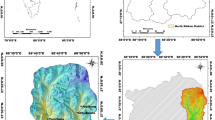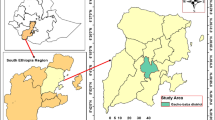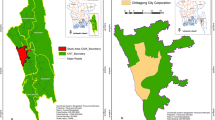Abstract
Landslides are one of the most damaging disastrous phenomena that frequently lead to serious problems in hilly areas. The Namchi region of South Sikkim district as a part of Eastern Himalayas is not an exception to it. In the present study, multi-criteria analysis technique is used for landslide hazard zonation mapping. Various thematic layers, namely slope, rainfall distribution map, lineament density, drainage density, slope aspect, geology, land use/land cover and soil map, were integrated in a GIS platform (ArcGIS 10.1) to delineate landslide hazard zone. Analytic hierarchy process was used to determine the weight values of different factors. Relative rating values are assigned for the subclasses of each thematic layer based on their corresponding impact on the landslide triggers, and within a thematic layer, each class was assigned an ordinal rating from 0 to 9. The landslide hazard zonation map of Namchi region was produced based on weighted overly techniques. The landslide hazard map of Namchi region is divided into five vulnerable zones, namely very low-, low-, moderate-, high- and very high-hazard zones. Resulted landslide hazard zonation map was further validated with field study and geospatial technology-based analysis. The findings demonstrate high-landslide-hazard zones are associated with areas of active erosive processes (steep slopes/cut slopes/lineaments). The results indicate the villages Bomtar, Jorethang, Kopchey, Donok, Namthang, Sumbuk, Longchok, Mamring, Turung, Mikkhola, etc. are highly prone to landslides. The final landslide hazard zonation map can be used for the landslide hazard prevention, proper planning of future infrastructure and geoenvironmental development in Namchi region.





Source: Pal et al. (2008)



Source: Geological Survey of India










Similar content being viewed by others
References
Ahmad RA, Singh RP, Adris A (2017) Seismic hazard assessment of Syria using seismicity, DEM, slope, active faults and GIS. Remote Sens Appl Soc Environ 6:59–70. https://doi.org/10.1016/j.rsase.2017.04.003
Ahmed B (2015) Landslide susceptibility mapping using multi-criteria evaluation techniques in Chittagong Metropolitan Area, Bangladesh. Landslides 12(6):1077–1095. https://doi.org/10.1007/s10346-014-0521-x
Ahmed MF, Rogers JD, Ismail EH (2014) A regional level preliminary landslide susceptibility study of the upper Indus river basin. Eur J Remote Sens 47(1):343–373. https://doi.org/10.5721/eujrs20144721
Anbalagan R, Kumar R, Parida S, Lakshmanan K (2014) GIS based post earthquake landslide hazard zonation mapping of Lachung Basin, Sikkim. Int J Emerg Technol Adv Eng 4(1):431–441
Anbalagan R, Kumar R, Lakshmanan K, Parida S, Neethu S (2015) Landslide hazard zonation mapping using frequency ratio and fuzzy logic approach, a case study of Lachung Valley, Sikkim. Geoenviron Disasters 2(6):1–17. https://doi.org/10.1186/s40677-014-0009-y
Anbarasu K, Sengupta A, Gupta S, Sharma SP (2010) Mechanism of activation of the Lanta Khola landslide in Sikkim Himalayas. Landslides 7:135–147. https://doi.org/10.1007/s10346-009-0193-0
Avtar R, Singh CK, Singh G, Verma RL, Mukherjee S, Sawada H (2011) Landslide susceptibility zonation study using remote sensing and GIS technology in the Ken-Betwa River Link area, India. Bull Eng Geol Environ 70(4):595–606. https://doi.org/10.1007/s10064-011-0368-5
Bera A, Mukhopadhyay BP, Das D (2018) Morphometric analysis of Adula River Basin in Maharashtra, India using GIS and Remote Sensing techniques. In: Geo-spatial data in natural resources, pp 13–35. https://doi.org/10.21523/gcb5.1702
Calligaris C, Poretti G, Tariq S, Melis MT (2013) First steps towards a landslide inventory map of the Central Karakoram National Park. Eur J Remote Sens 46(1):272–287. https://doi.org/10.5721/eujrs20134615
Cárdenas NY, Mera EE (2016) Landslide susceptibility analysis using remote sensing and GIS in the western Ecuadorian Andes. Nat Hazards 81(3):1829–1859. https://doi.org/10.1007/s11069-016-2157-8
Chen Y, Khan S, Paydar Z (2010) To retire or expand? A fuzzy GIS-based spatial multi-criteria evaluation framework for irrigated agriculture. Irrig Drain 59(2):174–188. https://doi.org/10.1002/ird.470
Chopra BR (1977) Landslides and other mass movements along roads in Sikkim and North Bengal. Bull Int As Eng Geol 16(1):162–166
Dai F, Lee C (2002) Landslide characteristics and slope instability modeling using GIS, Lantau Island, Hong Kong. Geomorphology 42(3–4):213–228. https://doi.org/10.1016/s0169-555x(01)00087-3
Devkota KC, Regmi AD, Pourghasemi HR, Yoshida K, Pradhan B, Ryu IC, Dhital MR, Althuwaynee OF (2013) Landslide susceptibility mapping using certainty factor, index of entropy and logistic regression models in GIS and their comparison at Mugling-Narayanghat road section in Nepal Himalaya. Nat Hazards 65(1):135–165. https://doi.org/10.1007/s11069-012-0347-6
Feizizadeh B, Blaschke T (2013) GIS-multicriteria decision analysis for landslide susceptibility mapping: comparing three methods for the Urmia lake basin, Iran. Nat Hazards 65(3):2105–2128. https://doi.org/10.1007/s11069-012-0463-3
Feizizadeh B, Roodposhti MS, Jankowski P, Blaschke T (2014) A GIS-based extended fuzzy multi-criteria evaluation for landslide susceptibility mapping. Comput Geosci 73:208–221. https://doi.org/10.1016/j.cageo.2014.08.001
Ghosh C (2013) Landslides induced damages due to recent Sikkim earthquake: strategies for geotechnical intervention. In Proceedings of the international symposium on engineering under uncertainty: safety assessment and management (ISEUSAM-2012). Springer, India, pp 1289–1298
Gorsevski PV, Jankowski P, Gessler PE (2006) An heuristic approach for mapping landslide hazard by integrating fuzzy logic with analytic hierarchy process. Control Cybern 35:121–146
Greenway DR (1987) Vegetation and slope stability. In: Anderson MG, Richards KS (eds) slope stability. Wiley, New York, pp 187–230
Guzzetti F, Carrara A, Cardinali M, Reichenbach P (1999) Landslide hazard evaluation: a review of current techniques and their application in a multi-scale study, Central Italy. Geomorphology 31(1):181–216. https://doi.org/10.1016/S0169-555X(99)00078-1
Hadmoko DS, Lavigne F, Samodra G (2017) Application of a semiquantitative and GIS-based statistical model to landslide susceptibility zonation in Kayangan Catchment, Java, Indonesia. Nat Hazards 87:437–468. https://doi.org/10.1007/s11069-017-2772-z
Hindayar JN, Dasarwar P, Srivastava SP, Kumar NT, Mohan M, Som SK (2016) Dynamicity of the Himalayan landslide—a tectono-geotechnical appraisal of the 13th mile landslide, Sikkim. J Geol Soc India 88:197–205. https://doi.org/10.1007/s12594-016-0478-6
Hong Y, Adler R, Huffman G (2007) Use of satellite remote sensing data in the mapping of global landslide susceptibility. Nat Hazards 43:245–256. https://doi.org/10.1007/s11069-006-9104-z
Kanwal S, Atif S, Shafiq M (2016) GIS based landslide susceptibility mapping of northern areas of Pakistan, a case study of Shigar and Shyok Basins. Geom Nat Hazards Risk. https://doi.org/10.1080/19475705.2016.1220023
Kolat C, Ulusay R, Suzen ML (2012) Development of geotechnical microzonation model for Yenisehir (Bursa, Turkey) located at a seismically active region. Eng Geol 127:36–53. https://doi.org/10.1016/j.enggeo.2011.12.014
Kouli M, Loupasakis C, Soupios P, Vallianatos F (2010) Landslide hazard zonation in high risk areas of Rethymno Prefecture, Crete Island, Greece. Nat Hazards 52(3):599–621. https://doi.org/10.1007/s11069-009-9403-2
Lee S, Choi J, Min K (2004) Probabilistic landslide hazard mapping using GIS and remote sensing data at Boun, Korea. Int J Remote Sens 25(11):2037–2052. https://doi.org/10.1080/01431160310001618734
Lei CI (2012) Earthquake-triggered landslides. In: 1st Civil and environmental engineering student conference, 25–26 June 2012. Imperial College, London
Mahdadi F, Boumezbeur A, Hadji R, Kanungo DP, Zahri F (2018) GIS-based landslide susceptibility assessment using statistical models: a case study from Souk Ahras province, NE Algeria. Arab J Geosci 11:476. https://doi.org/10.1007/s12517-018-3770-5
Mathew J, Jha VK, Rawat GS (2007) Application of binary logistic regression analysis and its validation for landslide susceptibility mapping in part of Garhwal Himalaya, India. Int J Remote Sens 28(10):2257–2275. https://doi.org/10.1080/01431160600928583
Othman AN, Naim WM, Noraini S (2012) GIS based multi-criteria decision making for landslide hazard zonation. Procedia Soc Behav Sci 35:595–602. https://doi.org/10.1016/j.sbspro.2012.02.126
Pachauri A, Pant M (1992) Landslide hazard mapping based on geological attributes. Eng Geol 32(1–2):81–100. https://doi.org/10.1016/0013-7952(92)90020-y
Pal I, Nath SK, Shukla K, Pal DK, Raj A, Thingbaijam KKS, Bansal BK (2008) Earthquake hazard zonation of Sikkim Himalaya using a GIS platform. Nat Hazards 45(3):333–377. https://doi.org/10.1007/s11069-007-9173-7
Pandey A, Dabral PP, Chowdary VM, Yadav NK (2008) Landslide hazard zonation using remote sensing and GIS: a case study of Dikrong river basin, Arunachal Pradesh, India. Environ Geol 54(7):1517–1529. https://doi.org/10.1007/s00254-007-0933-1
Pareta K (2004) Hydro-geomorphology of Sagar district (MP): a study through remote sensing technique. In: Proceeding in XIX MP young scientist congress, Madhya Pradesh council of science and technology (MAPCOST), Bhopal
Paulín GL, Bursik M, Hubp JL, Mejía LMP, Quesada FA (2014) A GIS method for landslide inventory and susceptibility mapping in the Río El Estado watershed, Pico de Orizaba volcano, México. Nat Hazards 71:229–241. https://doi.org/10.1007/s11069-013-0911-8
Ramli MF, Yusof N, Yusoff MK, Juahir H, Shafri HZM (2010) Lineament mapping and its application in landslide hazard assessment: a review. Bull Eng Geol Environ 69:215–233. https://doi.org/10.1007/s10064-009-0255-5
Rawat MS, Rawat BS, Joshi V, Kimothi MM (2012) Statistical analysis of Landslide in South district, Sikkim, India: using Remote Sensing and GIS. J Environ Sci Toxicol Food Technol 2(3):47–61
Saaty TL (1980) The analytic hierarchy process. McGraw-Hill, New York
Saaty TL (1990) How to make a decision: the analytic hierarchy process. Eur J Oper Res 48(1):9–26. https://doi.org/10.1016/0377-2217(90)90057-I
Sarkar S, Kanungo DP (2004) An integrated approach for landslide susceptibility mapping using remote sensing and GIS. Photogramm Eng Remote Sens 70(5):617–625. https://doi.org/10.14358/pers.70.5.617
Sarkar SS, Ali MA, Bhattacharya G (2012) Geology and mineral resources of Sikkim. Report, Geological Survey of India, West Bengal, Kolkata
Sengupta A, Gupta S, Anbarasu K (2010) Rainfall thresholds for the initiation of landslide at Lanta Khola in north Sikkim, India. Nat Hazards 52(1):31–42. https://doi.org/10.1007/s11069-009-9352-9
Shit PK, Bhunia GS, Maiti R (2016) Potential landslide susceptibility mapping using weighted overlay model (WOM). Model Earth Syst Environ 2(1):1–10. https://doi.org/10.1007/s40808-016-0078-x
Singh P, Gupta A, Singh M (2014) Hydrological inferences from watershed analysis for water resource management using remote sensing and GIS techniques. Egypt J Remote Sens Space Sci 17(2):111–121. https://doi.org/10.1016/j.ejrs.2014.09.003
Stanley T, Kirschbaum DB (2017) A heuristic approach to global landslide susceptibility mapping. Nat Hazards 87(1):145–164. https://doi.org/10.1007/s11069-017-2757-y
Van Westen CJ, Ghosh S, Jaiswal P, Martha TR, Kuriakose SL (2011) From landslide inventories to landslide risk assessment; an attempt to support methodological development in India. In: Proceedings of the second world landslide forum, 3–7 Oct 2011, Rome
Varnes DJ (1984) Landslide hazard zonation: a review of principles and practice. UNESCO Press, Paris
Acknowledgements
The authors are thankful to the Indian Institute of Remote Sensing (IIRS), Indian Space Research Organization (ISRO) and Indian Meteorological Department (IMD) for continuous support during the work. We are thankful to Dr. Vladimír Schenk (Editor in Chief, Natural Hazards) for suggesting modifications, which improved our manuscript. The authors also extend their thanks to anonymous reviewers for the valuable comments and suggestions.
Author information
Authors and Affiliations
Corresponding author
Ethics declarations
Conflict of interest
On behalf of all authors, the corresponding author states that there is no conflict of interest.
Additional information
Publisher's Note
Springer Nature remains neutral with regard to jurisdictional claims in published maps and institutional affiliations.
Rights and permissions
About this article
Cite this article
Bera, A., Mukhopadhyay, B.P. & Das, D. Landslide hazard zonation mapping using multi-criteria analysis with the help of GIS techniques: a case study from Eastern Himalayas, Namchi, South Sikkim. Nat Hazards 96, 935–959 (2019). https://doi.org/10.1007/s11069-019-03580-w
Received:
Accepted:
Published:
Issue Date:
DOI: https://doi.org/10.1007/s11069-019-03580-w




